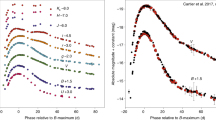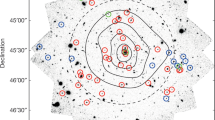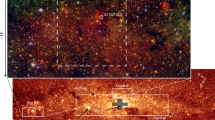Abstract
About 200 supernova remnants have been found in the galaxy1, six of which are younger than about 1,000 years (ref. 2). Observations of these young remnants are important for understanding of the late phases of supernova evolution, and each new object should add substantially to our knowledge of the processes involved. Here I report the discovery of a supernova remnant (RXJ0852.0 − 4622), identified by its X-ray emission, at the southeast corner of the known Vela supernova remnant. The high temperature (>3 × 107 K) indicates an age of less than ∼1,500 yr. The observed diameter of the remnant is about 2°, which suggests a distance of less than 1 kpc, based on a comparison with the remnant of the supernova of AD1006. RXJ0852.0 − 4622 may therefore be the nearest supernova to have occurred during recent human history.
This is a preview of subscription content, access via your institution
Access options
Subscribe to this journal
Receive 51 print issues and online access
$199.00 per year
only $3.90 per issue
Buy this article
- Purchase on Springer Link
- Instant access to full article PDF
Prices may be subject to local taxes which are calculated during checkout

Similar content being viewed by others
References
Green, D. A. A Catalogue of Galactic Supernova Remnants (1996 August version) (Mullard Radio Astronomy Observatory, Cambridge, UK); available at http://www.mrao.cam.ac.uk/surveys/snrs/.
Strom, R. G. “Guest stars”, sample completeness and the local supernova rate. Astron. Astrophys. 288, L1–L4 (1994).
Haslam, C. G. T., Salter, C. J., Stoffel, H. & Wilson, W. E. A408 Mhz all-sky continuum survey. II. The atlas of contour maps. Astron. Astrophys. Suppl. 47, 1–143 (1982).
Duncan, A. R., Stewart, R. T., Haynes, R. F. & Jones, K. L. The Vela supernova remnant and the Gum nebula: new perspectives at 2.4 GHz. Mon. Not. R. Astron. Soc. 280, 252–266 (1996).
Milne, D. K. Radio emission from the supernova remnant Vela-X. Aust. J. Phys. 21, 201–219 (1968).
Bock, D. C.-J., Turtle, A. J. & Green, A. J. Ahigh-resolution radio survey of the Vela supernova remnant. Astron. J. (accepted).
Koyama, K. et al. Evidence for shock acceleration of high-energy electrons in the supernova remnant SN1006. Nature 378, 255–258 (1995).
Willingale, R., West, R. G., Pye, J. P. & Stewart, G. C. ROSAT PSPC observations of the remnant of SN1006. Mon. Not. R. Astron. Soc. 278, 749–762 (1996).
Reynolds, S. P. Synchrotron models for X-rays from the supernova remnant SN 1006. Astrophys. J. 459, L13–L16 (1996).
. Winkler, P. F. & Long, K. S. X-ray and optical imagery of the SN 1006 supernova remnant. Astrophys. J. 491, 829–838 (1997).
Murphy, D. C. & May, J. Molecular clouds in Vela. Astron. Astrophys. 247, 202–214 (1991).
Becker, W., Brazier, K. T. S. & Trümper, J. ROSAT observations of PSR 2334 + 61 in the supernova remnant G 114.3 + 0.3. Astron. Astrophys. 306, 464–466 (1996).
Iyudin, A. F. et al. Emission from 44Ti associated with a previously unknown Galactic supernova. Nature 396, 142–144 (1998).
Aschenbach, B., Egger, R. & Trümper, J. Discovery of explosion fragments outside the Vela supernova remnant boundary. Nature 373, 587–590 (1995).
Acknowledgements
I thank D. Bock for permission to quote the Vela Z data before publication. I note that the discovery reported in this Letter was made in early 1996, but not published. The confirmation that RXJ0852.0 − 4622 is a young, nearby SNR separate from the Vela SNR came later from A. Iyudin. I thank A. Iyudin for telling me about the discovery of 44Ti γ-ray line emission from RXJ0852.0 − 4622 (ref. 13), which then prompted the current publication.
Author information
Authors and Affiliations
Corresponding author
Rights and permissions
About this article
Cite this article
Aschenbach, B. Discovery of a young nearby supernova remnant. Nature 396, 141–142 (1998). https://doi.org/10.1038/24103
Received:
Accepted:
Issue Date:
DOI: https://doi.org/10.1038/24103
This article is cited by
-
A rapid cosmic-ray increase in BC 3372–3371 from ancient buried tree rings in China
Nature Communications (2017)
-
Method to calculate the neutrino flux from a resolved source of high energy gamma-rays: the case of SNR RX J1713.7-3946
Astrophysics and Space Science (2014)
-
Supernova remnants: the X-ray perspective
The Astronomy and Astrophysics Review (2012)
-
Particle acceleration in supernova-remnant shocks
Astrophysics and Space Science (2011)
Comments
By submitting a comment you agree to abide by our Terms and Community Guidelines. If you find something abusive or that does not comply with our terms or guidelines please flag it as inappropriate.



